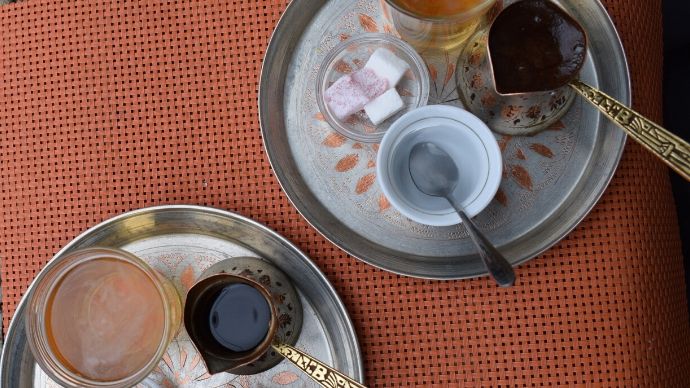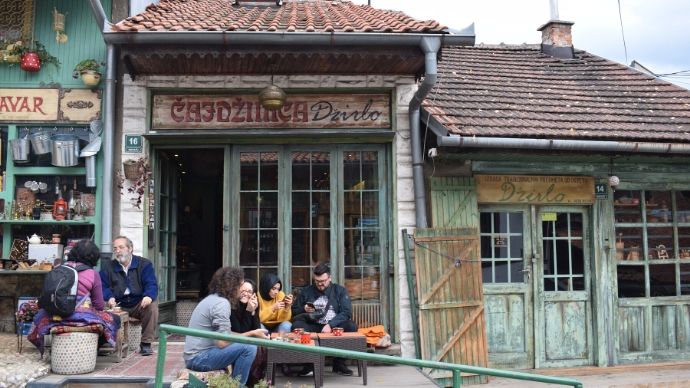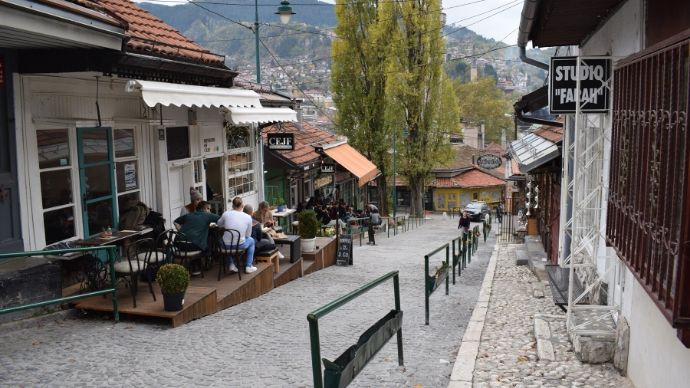How about a country where coffee isn’t just a drink but it’s a part of a cultural experience? Welcome to Sarajevo, the capital of Bosnia and Herzegovina! Today, we’re exploring the coffee of this small Balkan country and discovering what’s so special about it.
We’ll talk about Bosnian coffee (which is completely different from Turkish coffee), I’ll let you in on a secret location where you can get authentic Bosnian coffee set and a recipe on how to make Bosnian coffee at home.
[su_note note_color=”#fcf7e6″]When you buy a product via the links on IlCappuccinoExpress.com, I may earn a small affiliate commission at no extra cost to you.[/su_note]
Bosnian coffee is more than just coffee. It’s an important part of the Bosnian identity. I’ve always considered it to be an authentic experience and I love to relive it every time I’m in Sarajevo. It’s a city I came to love the first time I visited it and not much has changed since then. The only difference is that every time I visit, I discover something new that I missed during my previous visit.
Contents
What is Bosnian coffee?
Bosnian coffee is a rich and fragrant coffee that’s prepared in a special way. In order to get it right, there are a few musts when making this type of coffee.
But before we get to the actual recipe, let’s talk about this coffee for a bit. What’s the big deal about it? What is it, really?
Well, Bosnia and Herzegovina used to be a part of the Ottoman empire a long time ago. The Turkish rule is no longer there, but the influences of four centuries of their rule remain to be seen still; you can notice it in architecture, similar words (though rarely), a glass of rakija after dinner. And, in coffee. But, pay attention, as here things get interesting:
But where other countries in Southeast Europe, Western Asia, and North Africa still serve what is essentially Turkish coffee (they use the same methods and finely ground beans; they just give the drink a regional name) Bosnia-Hercegovina is one of the few places where calling the coffee by an eponymous name isn’t just a point of national pride. It’s a matter of distinction. (BBC Travel)
Bosnian coffee may use a similar process and same utensils when it comes to making Turkish coffee, but there are few minor yet distinctive differences that set two apart from one another.
The coffee in Bosnia is an important part of the daily life and it’s considered a social event and a custom. Coffee is not about getting loaded on caffeine in a matter of minutes while you’re doing your chores around town. Coffee is considered an event. You sit down with a company of friends, sipping it slowly, chatting, smoking (or not) and taking life easy. I’m a big fan of taking it slow, so this was a great discovery for me when I visited Sarajevo for the first time!

What is a Bosnian coffee set?
There’s more to Bosnian coffee than just one coffee maker and a mug of choice. We’re talking serious traditions here. The coffee set is an important and absolutely beautiful thing to observe, use, and own.
The complete set is called kahveni takum and it consists of:
- A tabla (copper tray)
- A džezva (coffee maker, a pot with a handle)
- A šećerluk (a container for ratluk and sugar)
- Fildžani (demitasse cups for coffee without handles)
I also discovered that in the older days, men would traditionally drink from very small cups since they were talking business. Women, on the other hand, drank from a larger fildžani with weaker coffee and a bit of added milk.
Traditionally, coffee should be served with a glass of water. That way, you clean the palate before you begin sipping and tasting the coffee.
How to make Bosnian coffee?
Just because you’re not in Bosnia, it doesn’t mean that you can’t make this type of coffee. I’d recommend you visit the beautiful country and taste the coffee when you can, but until then, here’s the only recipe you’ll need to make it:
You’ll need:
- A dzezva
- Freshly ground coffee
- A pot
- Water
- Sugar cubes
- Small coffee cups
For best effects, grind coffee beans just before you prepare coffee. If you don’t have a grinder, a pre-ground coffee works too, but it’s not the same.
Here’s how to make Bosnian coffee:
- Take a pot and fill it with water. Bring to a boil
- In the meantime, take dzezva and fill it with coffee
- Turn on heat to low-medium and warm dzezva with coffee in it (for a few seconds)
- Then, pour hot water from the first pot into dzezva (up to about ¾ of the dzezva)
- Place dzezva back onto the heat and bring it to a boil
- Once the coffee rises to the top of the coffee pot, take dzezva off the stove
- Pour over the remaining water up to the top of dzezva
- Serve it fresh with sugar cubes!
Why do you pour extra water over prepared coffee?
I’ve been told that this helps the floating coffee grounds settle at the bottom immediately. That way, you can enjoy coffee right away instead of waiting for a few minutes for the grounds to settle.
How much coffee do I use?
Here’s the thing; you use 1 teaspoon of coffee per cup. if you’re making 5 cups, use 5 teaspoons.
How much water do I use?
It depends on your dzezva. The bigger the coffee maker, the more water you’ll need.
What kind of coffee should I use?
The best grounds to use for Bosnian coffee is finely-ground coffee, the same as you would for Turkish coffee. It’s similar to espresso grind but even a bit finer. It’s best if you grind the coffee yourself, but if that’s not an option, make sure it’s finely ground.
How to say coffee in Bosnian?
If you want to order coffee, just say “bosansku kafu”.
https://www.youtube.com/watch?v=_ljVlaJA98c
How is Turkish coffee different?
Many Bosnians were happy to explain the difference between their and Turkish coffee for me. In essence, you use the same things to prepare it, but in a different way.
Bosnian coffee requires a few steps to get that final brew. Turkish coffee simplifies things a bit. Instead of separate steps of boiling water and warming cezve, add sugar water and coffee into the coffee pot all at the same time.
Place on the stove to low-medium heat and wait for the coffee to boil. Once it starts rising in the ibrik, remove from heat. Spoon out the crema/coffee bloom into each cup. Place the ibrik back on the stove and bring it to a boil again. When it boils, remove it from heat. Slowly pour the coffee into the cups to preserve the crema in the cups.
Serve with a glass of water to clean your palate before each sip and truly enjoy coffee.
Where can I drink Bosnian coffee?
The first time I tried Bosnian coffee in Sarajevo, was in the heart of Baščaršija, an ottoman rule leftover marketplace that’s buzzing with colorful small shops, cobbled streets, coffee shops, shishas, restaurants, souvenirs, coffee sets, and clothes.
The coffee I ordered was served in a copper džezva, with a small ceramic cup, 2 cubes of sugar, and a ratluk, on a copper tray. I thought I got as close to an authentic experience as I possibly could. Until I returned to Sarajevo a few years later.
Baščaršija isn’t the only place where you can get real Bosnian coffee. There are many funky local coffee shops around Sarajevo where they’ll serve you a fragrant hot drink in copper equipment. In fact, you can drink it outside of Sarajevo too (think Mostar and other towns), as long as you know what kind of coffee to order.
But the place where I always enjoy a cup of fragrantly fresh Bosnian coffee is a special one. I keep coming back to it because I love the owners, the atmosphere, and the relaxing vibe of the café. Let me introduce you to my favorite coffee place in Sarajevo!
Teahouse Džirlo: the heart of Bosnian coffee

For a real and authentic coffee experience in Sarajevo, head over to Teahouse Džirlo’s. Hussein looks like a rockstar met Jesus if he’d ever successfully grown old. With long white hair and beard, Džirlo is the exact impersonation of what I’d imagined an owner of that teahouse would look like. You’ll find him just off Baščaršija, located on a climbing street and the place is worth stopping by for the atmosphere alone.
This teahouse is a tiny, two-story café with vintage décor, wallpapers, old couches, sofas, ottomans, carpets. It’s a charming, cozy and a welcoming place where you’ll find yourself discovering more about coffee or Sarajevo; both Hussein and his wife Diana are very friendly and talkative people.
I can tell you from experience that they both know a lot about coffee and they’ll happily explain anything. There are a few things you’ll want to try once you’re there, but I recommend two beverages:
Salep
Salep is a kind of thick yet tasty and warm sweet drink made of dried orchid tubers. It’s served with a dash of cinnamon and it was just what I needed on a cold and dark November afternoon. This dessert-like beverage is made with milk or water and it’s a common drink in countries that were once a part of the Ottoman empire. The one served at Džirlo’s it delicious; put it on your to-do list especially if you love cinnamon.
Bosnian coffee with Serbe
There’s the Bosnian coffee, or bosanska kafa. But then there’s the special Bosnian coffee with serbe (šerbe) which I love. Serbe is a sweet syrup that accompanies the coffee. Hussein explained that it essentially replaces sugar and enjoy serbe instead with coffee sip by sip.
Here’s how you should drink it with coffee:
- A sip of šerbe
- A sip of coffee
- A sip of šerbe
- A sip of coffee
- And keep going until you’ve drunk your coffee and serbe
Where can I buy Bosnian coffee?
Well, Bosnia doesn’t necessarily grow its own coffee. But the coffee they use is very extremely finely ground. Think flour-consistency. While I was there, I noticed the brand Zlatna Dzezva everywhere with its green packets of coffee. It seems to be one of the most popular Bosnian coffee brands and you can even find it on Amazon!
Walking around Bascarsija, you may come across a shop that sells both ground coffee and beans, but none of these really convinced me. Perhaps you could visit Sarajevo during the coffee festival (it’s already on my to-do list) and find the best coffee then.
But to be honest, you don’t need to buy Zlatna Dzezva coffee to make Bosnian coffee. You can use the same type you normally would to make Turkish coffee.
Where can you buy authentic Bosnian coffee set?
You can buy a Bosnian coffee set online. There are a few online shops that sell it, including Etsy and Amazon. You can also probably find it on eBay.
However, I’ll share a tip with you if you happen to be in Sarajevo and want to buy the Bosnian coffee set.
Most guides and blogs will tell you that you can easily get it in Baščaršija, which is generally true. But there’s a secret to an authentic Bosnian coffee set for sale: you won’t get the real deal in Baščaršija. When I was there, I did my research, talked to the locals and discovered a few very helpful and interesting facts about the traditional coffee sets.
The majority of the merchandise you see in Baščaršija isn’t the authentic stuff. But let’s take it a step back: what do I mean by authentic?
Originally, these beautiful sets were hand made. There’s an old profession of copper shaping and it used to be an important part of Bosnian culture. But then the big markets became flooded with products from Turkey which are not authentic (not to Bosnia anyway) and not hand-made either.
But you can get a hand-made Bosnian coffee set in Sarajevo, and it’s very easy to find it!
Remember Džirlo’s teahouse? That street is called Kovaći street. And on that street, there are about 5 or 6 workshops that are the real deal.

The art of copper making has almost died out, but with a high unemployment rate and other problems, more people started picking up the old art again. Now they’re trying to attract visitors, spread the word, and make us understand that their stuff is the authentic thing that we want.
After all, by purchasing their work, we not only support them and help them support their families, but we also help to preserve this amazing tradition and focus on personalized products rather than those made on an industrious scale.
In case you want to know more, be sure to click around the following articles:
How Sarajevo’s Metalworkers Decided to Review their Craft and how does it look like for them since practicing these crafts used to be despised in Bosnia.
History of Handcraft and how it got to Bosnia, a short article by the only woman crafter on Kovači street today.
Walk through the streets of Sarajevo and get to know the complicated culture of Bosnian Coffee
Bosnian coffee: A recap
Bosnian coffee is much more than just a cup full of coffee. It’s a fresh of fragrant and rich history, cultural experience, social event, craftsmanship, and a detailed story sweetened with one sugar cube and a gentle piece of rose ratluk that melts in your mouth.
Get your own dzezve and give this coffee, high on caffeine and richness, a try. If you’re ever in Sarajevo, don’t forget to stop by at the Kovači street. Visit Džirlo’s and the craftsmen that pound their days away to the sound of copper tinkling, filling the street and shaping the atmosphere of this unique city.
[su_divider top=”no” style=”double” divider_color=”#cbcbcb” link_color=”#ffffff”]
Recommended Reading
Coffee Bean Types: all you need to know from bean to cup!
1o Best Pour Over Coffee Maker Reviews (All You Need to Know)
How to Make Italian-Style Coffee on the Stove?
Colombian Coffee Guide: the Taste, the Brands, the History
Animal Poop Coffee: How Shitty is it, Really?
Healthy Coffee Creamers and Homemade Alternatives
